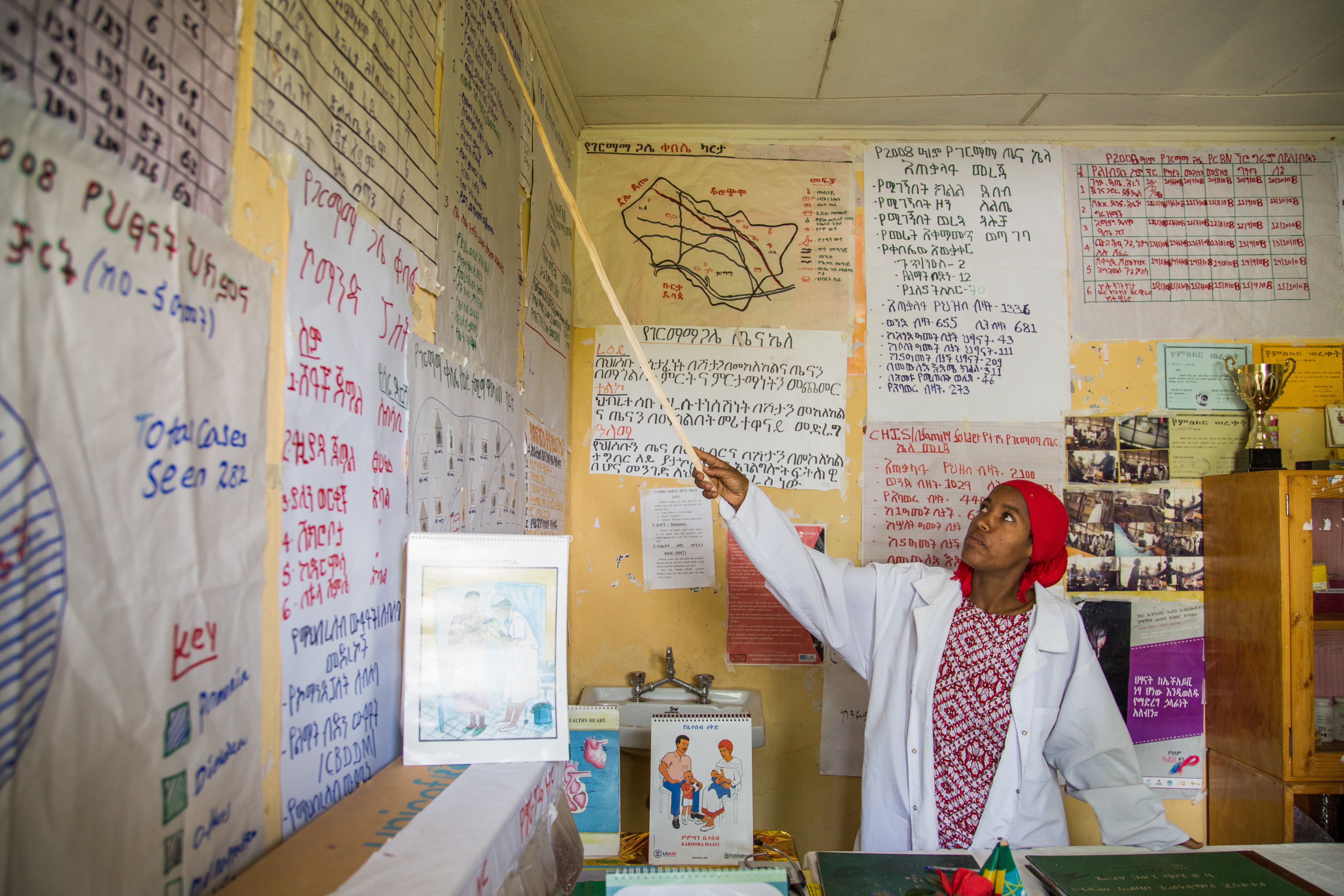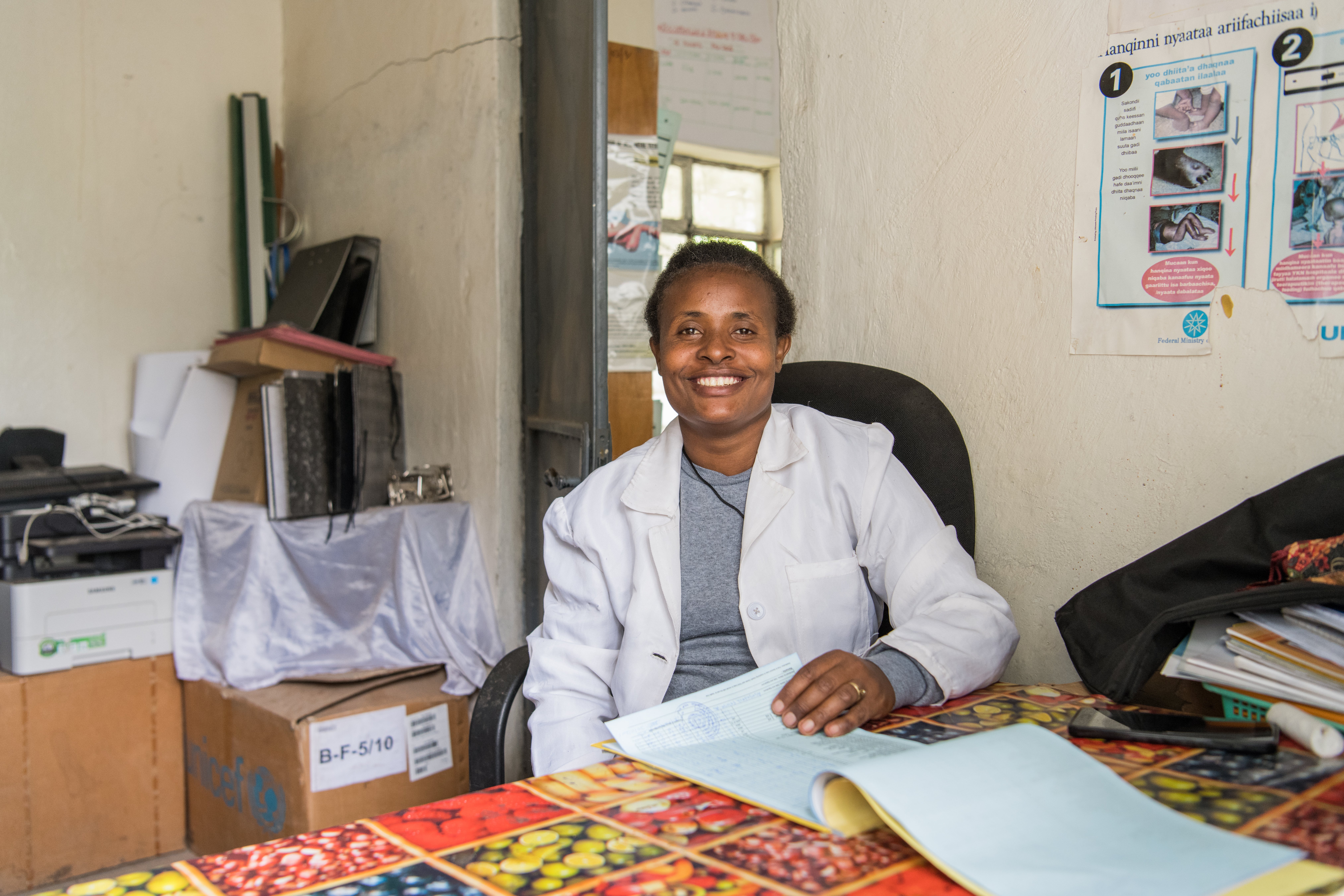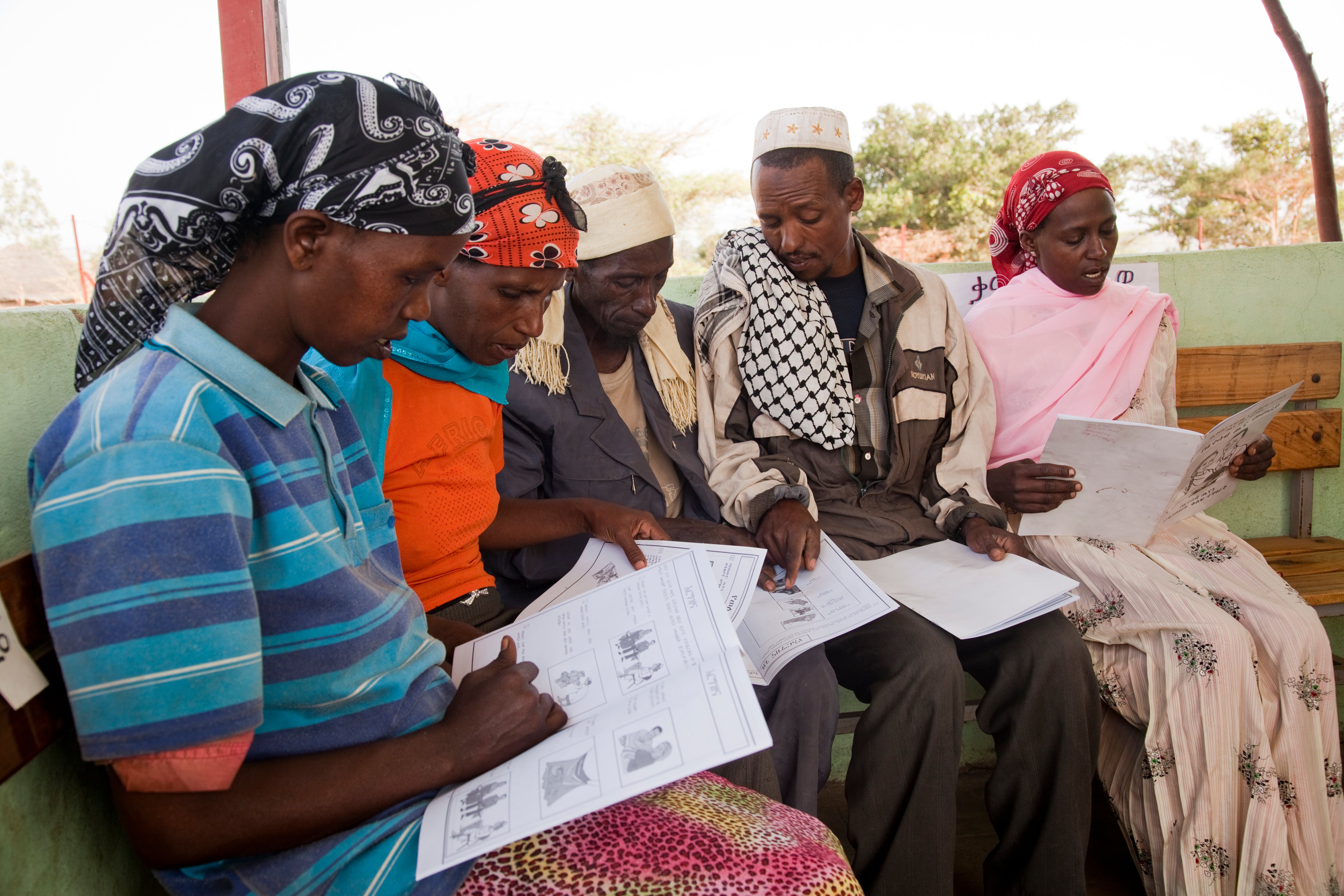Key Takeaway: Ethiopia has prioritized demand creation and expanding access to health services, largely focused on maternal, newborn, and child health, especially in rural communities. This section of the narrative summarizes the health care system in Ethiopia for context, then highlights selected programs and policies that have been particularly relevant to maternal and newborn health in the country. Many of these have also been influential in Ethiopia’s status as an Exemplar in other topics such as stunting reduction, community health workers, and under five mortality. A more complete policy timeline is included in the section.
Health System Structure
The Ethiopian healthcare system is organized into three tiers through which services are provided. These primary, secondary, and tertiary tiers play distinct roles as designed through the Health Extension Program (HEP), which is the main avenue for providing primary health care in Ethiopia and is described in detail later in this section.
Figure 21: Health System Structure in Ethiopia

Assefa, Yibeltal, et al. "Community health extension program of Ethiopia, 2003–2018: successes and challenges toward universal coverage for primary healthcare services." Globalization and health 15 (2019): 1-11. https://globalizationandhealth.biomedcentral.com/articles/10.1186/s12992-019-0470-1
Through this structuring, a pair of Health Extension Workers (HEWs) are assigned to one health post, the primary level health care units, which serve a population ranging from about 3,000 to 5,000 people in a kebele (village). In communities, five primary health posts are associated with a health center and primary hospital that function as referral facilities, collectively comprising a primary health care unit (PHCU). Primary hospitals provide emergency, impatient, and ambulatory services. Secondary level general hospitals and tertiary specialized hospitals also exist for more complicated cases, although these facilities are generally located in urban centers.

To move towards universal coverage, Ethiopia has prioritized expanding the country’s network of health facilities in recent decades. The density of health posts, health centers, and hospitals have all increased in the past two decades, especially health posts which have been crucial in expanding access to care in rural areas. The density of health posts increased particularly dramatically as in 2000 there were 1.4 health posts per 100,000 people but by 2021 this had increased to 17.2 health posts per 100,000 people.
Figure 22: Health Facility Density in Ethiopia from 2000 to 2021

WHO Global Health Observatory. Accessed April 12, 2023. https://www.who.int/data/gho/indicator-metadata-registry/imr-details/3120
Health Extension Program
Expanding access to primary health care (PHC), particularly in rural areas, became a government priority for Ethiopia after assessing low coverage of PHC services in 2000, including essential maternal and newborn health services. Initiated in 2003, the Health Extension Program (HEP) was developed in order to provide a mechanism for universal coverage for PHC services, large targeting rural areas.
To achieve this, Ethiopia enacted a series of five-year Health Sector Development Plans (HSDP) and Health Sector Transformation Plans (HSTP) beginning in 1997, each having a distinct focus that contributed to mortality reduction progress seen in Ethiopia.
Arguably the most influential of these for maternal and neonatal health was the Health Sector Development Plan -II (HSDP-II), 2002/2003-2005/2006, which included the rollout of the Health Extension Program (HEP). HEP began in the four larger agrarian regions, then later expanded to pastoralist communities in 2006, and to urban centers in 2009.
The goal of the HEP is to provide essential health services rooted in health promotion prevention and basic curative services to households at the community level. At its inception, the program included 17 ‘health packages’ grouped into the four categories of family health services, disease prevention and control, hygiene and environmental sanitation, and health education and communication.
Figure 23: Packages of the Rural Health Extension Program of Ethiopia

Assefa, Yibeltal, et al. "Community health extension program of Ethiopia, 2003–2018: successes and challenges toward universal coverage for primary healthcare services." Globalization and health 15 (2019): 1-11. https://globalizationandhealth.biomedcentral.com/articles/10.1186/s12992-019-0470-1
The HEP has achieved success in key MNH services such as family planning, immunization, ANC, malaria, TB, HIV, and has contributed to increased hygiene and environmental health as well as community engagement in health. Service utilization has increased alongside high levels of community satisfaction seen through increased health seeking behavior of mothers for common childhood illnesses. The major objectives of the HEP are multifaceted – the program aims to reduce morbidity, disability and mortality, through increased access and awareness of family health services and disease prevention and control through proper hygiene and sanitation by way of involving communities through health education and communication. This innovative approach has brought positive changes in knowledge attitudes and behaviors to populations at large.
The impact of this program was often highlighted among interview respondents, with one informant saying:
"The HEP is a program we are proud of, that helped to bring these changes. Since it improves access to the community, I believe designing the HEP brought a big change in bringing a sharp decline on maternal, infant, and under-five mortality. If you ask me to select one program, I firmly say that the results are attributed to HEP. If the HEP was not implemented, we couldn't have achieved these results."
Figure 24: Maternal and Newborn Health Services Provided by the Health Extension Program

Karim, Ali Mehryar, et al. "Effect of Ethiopia’s health extension program on maternal and newborn health care practices in 101 rural districts: a dose-response study." PloS one 8.6 (2013): e65160. https://pubmed.ncbi.nlm.nih.gov/23750240/
Health Extension Workers
Health Extension Workers (HEWs) are the key mechanism for how the HEP is implemented within communities. After completing a 12-month training program, HEWs become salaried government employees to health posts and engage directly with households. HEWs serve as link from households to health packages, but also expected to prioritize village health concerns, draft plans of action, and provide let health services through health posts and through outreach activities. They spend 75% between home visits and outreach activities, while 25% of their time is to be spent at the health post providing basic curative, promotive and preventive services.
Since its origin through HSDP-II, the HEP and the roles and responsibilities of HEWs have evolved. With each new HSDP, the HEP expanded as noted earlier, including a ‘flooding strategy’ in which large numbers of HEWs were trained to keep pace with rapid expansions in the country’s networks of health posts.

Health Development Army
Community engagement is further facilitated by a Health Development Army (HDA) comprised of up to 30 households in a neighborhood that collaborate to promote and improve health. These groups identify local issues and play a participatory role in solution design, with a coordinated overarching structure positioned to facilitate lesson-sharing across the country. HDAs are often comprised of sub-groups called one-to-five networks which each have their own leaders that coordinate with the larger HDA. Often times candidates for the position of leader within a one-to-five network may go to an individual who belongs to a ‘model family’. Model families are households that have been trained in the gamut of health packages offered through HEP, are able to implement these packages, and are well positioned to promote these learnings in their local community. As described above, HDA leaders help to make the PHCUs accessible and impactful for the surrounding communities and extend the reach of the health system beyond only health facilities.

Human Resources for Health
As the number of health facilities in Ethiopia has grown, so has the health workforce in the country. From HEWs to public health officers, to medical doctors, Ethiopia has invested in growing and training its diverse health workforce.
From 2003 to 2020 the number of doctors in Ethiopia increased from 1,936 to 12,174 while the number of nurse/midwives increased from 15,554 to 90,179., This growth has translated to improved health worker density, as in 2020 there were 1.04 doctors per 10,000 people in the population as compared to 0.27 in 2003. Similarly, the density of nurse/midwives per 10,000 people in the population has grown from 2.15 to 7.84 over this time span.
Figure 25: Healthcare Worker Density in Ethiopia from 2003 to 2020

WHO Global Health Workforce Statistics Database. Accessed April 12, 2023. https://www.who.int/data/gho/data/themes/topics/health-workforce
Surgical Officers
In response to a shortage of physicians and gynecologists trained to perform C-sections and other emergency obstetric procedures, the Ministry of Health partnered with local and global partners to develop training programs to empower non-physician health professionals to fulfill this need. In 2009, a three-year masters level training program was established at three universities in Ethiopia to train health professionals with at least a bachelor of science degree and two years of work experience. This innovative approach to expanding the health workforce has in particular helped make C-section more accessible across the country. Assessments of caregiver performance and patient perceptions indicate that this cadre of Integrated Emergency Surgery and Obstetrics (IESO) providers are able to deliver quality care to patients.
Ambulance Program
In 2012 Ethiopia enacted a national plan to distribute a four-wheeled ambulance in each rural district in the country. This was a key intervention as 71.1% of women in the 2011 DHS survey mentioned lack of transportation as a major barrier to care. A total of 1,250 ambulances were introduced to the country, with the local ambulance reachable via telephone. Each regional government agreed to cover recurring costs for the ambulances, replace them after five years, and ensure that ambulance transport is provided for free. This operating plan may present some longitudinal risks as maintenance and replacement may not be affordable, but there are early signs of the impact of this intervention. One impact assessment in the Tigray region indicates that there were substantially lower pregnancy-related mortality in places and periods where free ambulance transport was utilized. Another study in Tigray identified that HEWs played a key role in increasing skilled birth attendance coverage by arranging ambulance services both pre-emptively and after the onset of labor.
Maternity Waiting Homes
Another intervention intended to promote in-facility delivery and access to obstetric care was the scaleup of maternity waiting homes in 2015 so that they would be accessible to all women, not only those who presented an elevated risk. By revising the national guidelines around maternity waiting homes, these waiting homes have been rapidly expanded and as of 2019 were present in half of facilities. There is a growing body of evidence that maternal and perineonatal mortality rates are both lower at facilities with maternity waiting homes than facilities without this service.,These homes are meant to provide a place for mothers to stay in the nights preceding their delivery so that they may await care near a health facility as opposed to an isolated rural area. Maternity waiting homes allow a mother to undertake the potentially lengthy commute to a health facility in advance, as opposed to during the more intense moments as she begins or enters labor. Interview respondents spoke positively about maternity waiting homes, as one described:
"It is like a full-fledged home. Everything is there. If she delivered there, there is porridge. There is also TV. All family members come with her and support. They can make coffee ceremony and prepare food."
